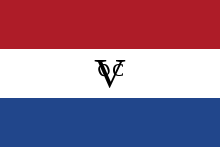Jacob Borghorst
Jacob Borghorst, also Borchorst, was the fourth Commander of the Dutch Cape Colony from 1668 to 1670. He was in ill health for most of his period as Commander, and left most of the administration to his subordinates. Borghorst and his family returned to the Dutch Republic in 1670.[1]
Jacob Borghorst | |
|---|---|
| 4th Commander of the Cape | |
| In office 18 June 1668 – 25 March 1670 | |
| Preceded by | Cornelis van Quaelberg |
| Succeeded by | Pieter Hackius |
Background
Borghort's family came from North Holland. He entered service with the Dutch East India Company (VOC) as an assistant in India and was promoted to onderkoopman (junior merchant) in 1646. In 1653, he left to become a merchant in Ceylon, leaving in March 1663 as a second-in-command. He served briefly as administrator in Colombo, and several briefings to Jan van Riebeeck in 1655 bear his signature.
On December 24, 1664, after a successful career in the service of the VOC, he left Batavia for the Netherlands on the Phoenix, serving as vice-commander on one of the ships in Pieter de Bitter's return fleet. The fleet stayed in Cape Town from March 11 to April 22 of 1665 to resupply. During their return voyage, the Second Anglo-Dutch War broke out, and the valuable merchant fleet sought shelter in the neutral harbor of Bergen, Norway, but the Royal Navy did not respect the neutrality treaty and blockaded the port. In the resulting Battle of Vågen, De Bitter defeated the English but the latter captured the Phoenix on September 13, 1665.
Borghorst was plundered of eight bags of gemstones, which he had purchased in Europe to carry all the fortune he had built up over the year. This likely required him to start over with the VOC, who appointed him to the Cape as Commander in 1667.
Tenure as Commander
Borghorst left Texel, Netherlands, for the Cape on December 27, 1667 aboard the transport ship Hof van Breda, commissioned by the full Lords Seventeen of the VOC in Amsterdam. The ship carried 268 on a difficult journey: poor weather forced two stays in English harbors (only 6 months after the end of the war) as well as in Cape Verde, at the time a Portuguese colony. Most of the crew got sick and 25 of them died during the voyage.
Borghorst arrived at the Cape of Good Hope on 16 June 1668,[2] feeling weak and sick. On Sunday the 17th, Commander Cornelis van Quaelberg, not yet aware of his dismissal, came aboard to greet Borghorst, who came to the fort later that day. On the 18th, Van Quaelberg summoned the entire Political Council of the Colony to a meeting there to discuss the Lords Seventeen's letter replacing him. Due to delays in transferring financial records and inventory, the post (and with it the keys to the gates and stores) were not fully transferred to Borghorst until August 2. Given his illness, most of his duties were handled by bureaucrats such as the fiscal Cornelis de Cretzer, who would later fulfill the same function for equally frail Commander Pieter Hackius and die tragically in slavery in Algeria. Borghorst found the task unbearable and petitioned for dismissal immediately after arrival. The VOC appointed Jan van Aelmonden, a Batavia merchant, as his successor, but he could not arrive in time. Therefore, Hackius was appointed as such and Borghorst continued to serve as commander.
During his tenure as Commander, expeditions were launched inland and down the coast: a small village was founded near Saldanha. Borghorst encouraged grain cultivation and raised cattle himself, but was accused of taking the side of the Khoikhoi in disputes with settlers. He finished the canal from Zacharias Wagenaer's reservoir to the harbor, part of which was rediscovered during the building of the Golden Acre shopping center.
Departure
Hackius and his family arrived on board the ship Sticht van Utrecht on March 18, 1670,[3] and formally took office on the 25th of that month. On April 17, Borghorst formally resigned and left for the Netherlands on the Beemster.[4]
Borghorst apparently was a bachelor in the Cape, and it is unknown if he ever married.
Sources
- Böeseken, Dr. A.J. (1938). Nederlandse commissarissen aan de Kaap. The Hague: Martinus Nijhoff.
- Büttner, H.D. (1980). Kennis: die eerste Afrikaanse ensiklopedie in kleur, vol. 8, pp. 1474-1475. Capetown: Human & Rousseau. ISBN 0 7981 0830 4
- Catalogue of the Archives of the Dutch Central
- Government of Coastal Ceylon (1640–1796).
- Journal of Fort Batavia – March 31, 1663; May 17, 1664
- Krüger, Prof. D.W. (September 1958). “Jacob Borghorst.” Historia.
- Krüger, Prof. D.W. (ed.) (1972). Suid-Afrikaanse Biografiese Woordeboek. Cape Town: Tafelberg-Uitgewers.
- Picard, Hymen W.J. (1972). Masters of the Castle. Cape Town: C. Struik (Pty) Ltd.
- Molsbergen, EC Godée (1916). Reizen in Zuid-Afrika in de Hollandse tijd. The Hague: Martinus Nijhoff.
- Van Dam, P. (1939). Bescrijvinge der O.I.C. The Hague.
- Warnsinck, J. C. M. (1929). De Retourvloot van Pieter de Bitter. The Hague: Martinus Nijhoff.
References
- Rosenthal, Eric (1978). Encyclopaedia of Southern Africa (1st ed.). Cape Town: Juta and Company.
- "Hof van Breda (1667)". De VOCsite (in Dutch). 2020. Retrieved 22 February 2020.
- "Sticht van Utrecht (1667)". De VOCsite (in Dutch). 2020. Retrieved 22 February 2020.
- "Beemster (1667)". De VOCsite (in Dutch). 2020. Retrieved 22 February 2020.

